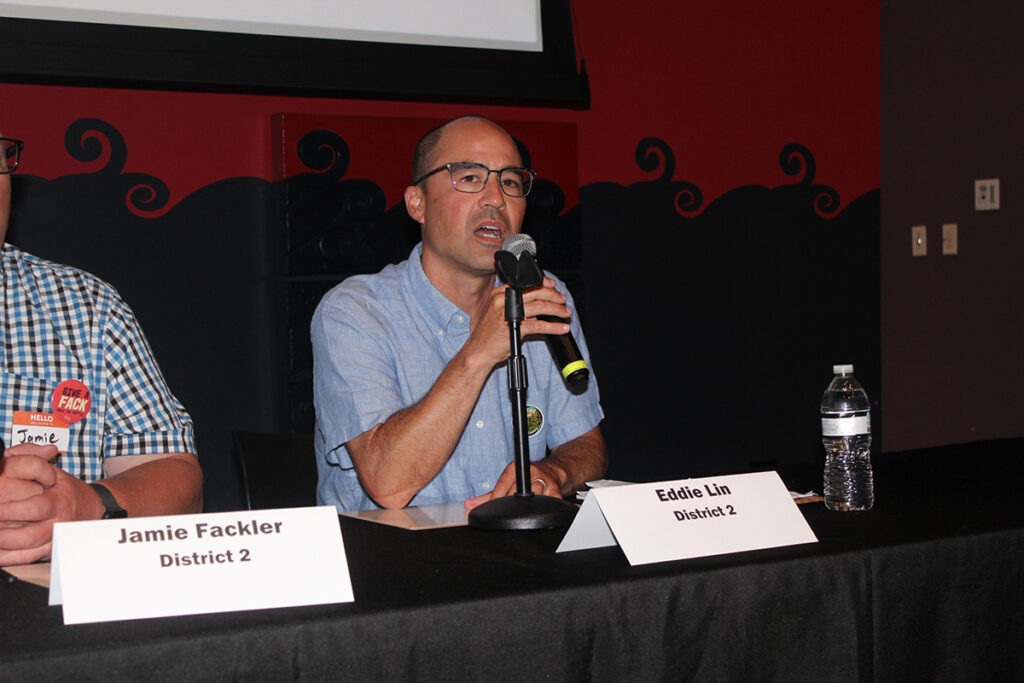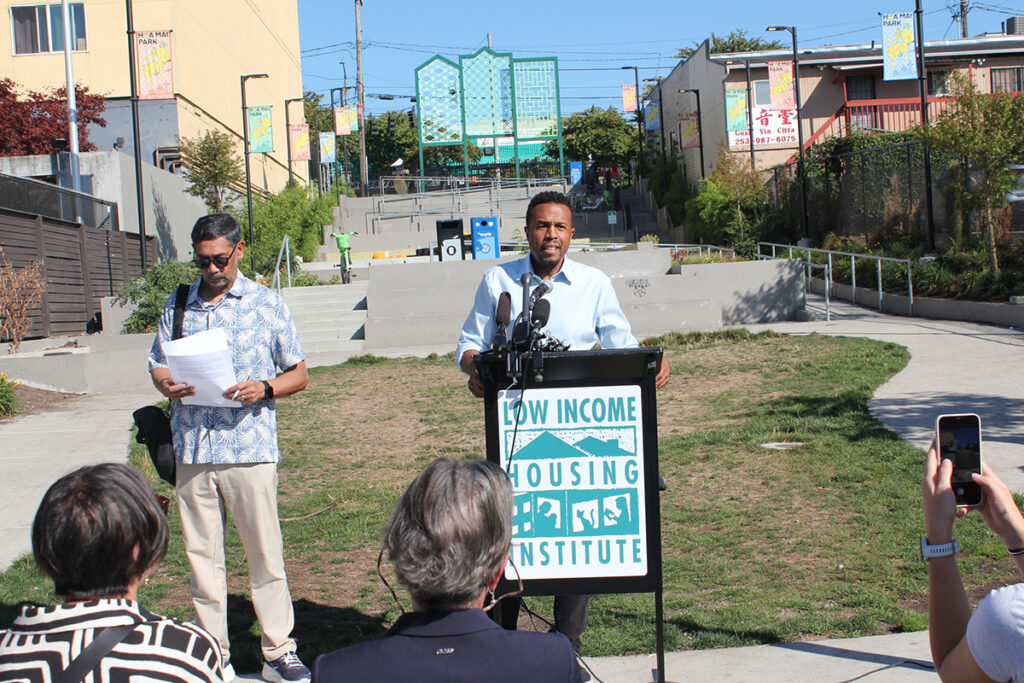By Carolyn Bick
NORTHWEST ASIAN WEEKLY
Seattle City Council (SCC) District 2 candidates Eddie Lin and Adonis Ducksworth may come from different backgrounds, but both are invested in making life easier for District 2’s residents—particularly those who come from vulnerable communities—and neither thinks that the city’s current plan to put surveillance cameras around the Chinatown-International District (CID) is a good idea. In fact, they both said, putting up cameras could be harmful for many in the CID community.
Lin and Ducksworth are running against each other in November’s general election. Whoever wins will fill the remainder of former Councilmember Tammy Morales’ term. District 2 encompasses the CID, Beacon Hill, Rainier Valley, Yesler Terrace, Rainier Beach, Columbia City, and Mount Baker. The pair appeared on The Seattle Channel on Sept. 15 to answer a series of questions about their focus areas, methods of approach, and personal histories that play into their campaigns.
Affordable housing

Eddie Lin at the A&NH/PI Primary Election Candidate Forum in July 23, 2025. (Photo by James Tabafunda)
Lin, who is of Taiwanese descent, currently works in the Seattle City Attorney’s Office (SCAO). One of his major focus areas is affordable housing, and he’s been working with the Office of Housing on affordable housing throughout the city.
“The primary reason I’m running is, so many families in District 2 South Seattle, really throughout the city, are struggling with the high cost of housing, childcare, utilities, groceries,” Lin said. “Families are getting pushed out and neighbors are getting pushed out onto the street. So, I want to do everything I can to lower costs for families, to help build shelters, get people off the street.”
Lin cited the state- and city-wide “enormous housing shortage,” as well as Seattle’s rate of growth that, for a time, placed it as the fastest-growing city in the country for a decade, and said that these two factors have meant skyrocketing housing costs. He said that his real estate legal background and his work with the SCAO are part of what makes him the better candidate for the job, because he understands “how development works and the barriers to building more housing.”
“There’s a statistic that when rents go up a hundred dollars, homelessness increases by 9%,” Lin said. “The work that I do with the Office of Housing is really good and meaningful and we’ve grown our investments. But the need has continued to outgrow our ability to build affordable housing, and that’s why we need to do a lot more on the market rate side on social housing.”
Asked how he would change the citywide affordable housing shortage, if elected, Lin said that the solution lies in zoning laws and making it easier to build throughout the city, not just in select areas.
“For many, many years, 75% of our city was exclusionary, and we need a more integrated city, more integrated between homeowners and renters,” he said. “We should not be putting all the density on major arterials. … We need denser walkable neighborhoods and to transition away from our over-reliance on vehicles as our primary mode of transportation.”
Lin, who lives in a single-family neighborhood, said that he uses a car “too much” to get around.
“We need to make it easy, and safe and reliable for folks to get around by bus, by transit, walking, biking—that’s how we’re gonna make it more affordable, safer,” he said. “It’s better for public health and, as climate change is upon us, there’s really no other option. So the quicker we make this transition to having more dense walkable neighborhoods, the sooner we’re going to see benefits.”
Lin also pointed to the fact that Seattle has “the second most per capita millionaires anywhere in the country.”
“We have enormous wealth and resources, but that’s only getting to some in our community and others are being left out,” Lin said. “That’s where a city government really needs to step up.”
Lin said that the city needs new shelters and affordable housing to combat the homelessness crisis, because pushing people experiencing homelessness from neighborhood to neighborhood doesn’t work. He said that the city needs to build more shelters and get people connected to tiny home villages. All of that requires new revenue, he said.
But the burden of that new revenue for these initiatives should not rest on the backs of elders on fixed incomes or low-income residents, who are already burdened. Those costs should be shouldered by those who can afford it, he said.
“We need to … pass capital gains tax, to increase the corporate payroll tax,” Lin said. He later stated again that the city needed to tax wealthy corporations to pay for core needs. “The wealthy folks in our community just got one of the largest tax cuts in history from the feds, but we’re going to see impacts locally with cuts to Medicaid and Medicare and education.”
Ducksworth is also keen to help mitigate the city’s housing crisis—and he has direct experience with it. Ducksworth shared a personal story about his father, a veteran who became homeless due to substance use disorder.
“It was heartbreaking for me, as someone who traveled around the city as a kid, to see my dad down on Third Avenue,” Ducksworth recalled. “He eventually died of his alcoholism. And that’s heartbreaking.”
“These folks that we see on the street today, we have to remember these were people’s dads. There’s people’s moms. They’re their brothers, their sisters. These are people you went to high school with,” he continued. “So we have to treat them with dignity. … It’s our responsibility to help them with quality treatment, quality shelter, build more tiny homes. That’s how we get out. That’s how we help them get off the street.”
Ducksworth agreed with Lin that zoning laws needed to change, and that the city should look to progressive revenue sources, like taxing the city’s wealthiest, to help fund affordable housing initiatives. He also said that the city needed to speed up its permitting process, which may include hiring more workers and more staff at the Seattle Department of Construction and Inspections.
“We’re looking at other opportunities to really speed up that permitting process so that we can get permits approved and in time, because that costs our builders money,” Ducksworth said. “Time is money. And when it’s too expensive to build, they go build in other places and they don’t build here.”
Surveillance cameras

Adonis Duckworth at a Sept. 16, 2025 news conference in Little Saigon (Photo by James Tabafunda)
Ducksworth said that he understands that the current Seattle City Council members are “trying to be responsive and they’re trying to do everything that they can to curb some of the things that are happening, like in … [the] CID, Little Saigon—but cameras are not the way to go.”
“We’re trying to build trust with our communities and especially what’s happening at the federal level with [Immigration and Customs Enforcement] (ICE) just breaking up families, illegally arresting people and really coming after our city—this is not the way to go,” Ducksworth said. “Cameras are not the way to go right now.”
“I couldn’t agree with Adonis more,” Lin said. “Now is not the time to be adding surveillance when Trump is not only threatening, but actually taking over police departments.”
“We need to be extremely careful about the information and data that we’re collecting and we should be looking at turning off cameras instead of adding more surveillance to our community,” he continued. Our immigrant communities … our LGBTQIA communities, women, and others who are seeking reproductive health care are fearful and are being targeted, and so we need to do whatever we can to protect our community.”
ICE has used public databases, including police departments’ caches of driver location data, to target immigrants for years. Since Trump’s election, ICE has significantly expanded its reach—including tapping into surveillance cameras much like the ones the SCC is pushing for the CID. Local police departments have turned over data from an AI-powered automatic license plate reader system to ICE for searches allegedly related to immigration and other investigations. The agency does not have a formal contract to use the system to access this data.
Gun violence
At the same time, neither Ducksworth nor Lin downplayed the gun violence District 2 sees.
Lin said that part of the solution lies in getting guns off the streets and into safe storage, as well as getting people connected with good jobs. He said that the upcoming Families, Education, Preschool, and Promise (FEPP) Levy would go a long way towards the latter.
He also highlighted the need for mental health services and social work services in schools, as well as the need to increase funding for and dedicating funding to community gun violence prevention programs.
“Too often, that funding is sporadic and intermittent, and we need to be building long-term relationships with our youth,” Lin said, “For these organizations like Choose 180 and Community Passageways to hire staff, to build those long-term relationships, they need secure, dedicated funding, not reapplying for it every year and not knowing if they’re going to be able to pay their staff.”
Ducksworth pointed to economic inequality as the root cause of gun violence, which mostly impacts Black and brown children in District 2.
“It is years and years and years of trauma, disinvestment, and … a lot of these kids and these young people, they don’t have anywhere to turn. They don’t have anywhere to go with our housing crisis,” Ducksworth said. “A lot of families have had to move and leave. And within the housing world, these families are … completely destabilized. And so what we really need to do with gun violence is we need to focus on prevention. We need to focus on support and we need to focus on diversion.”

